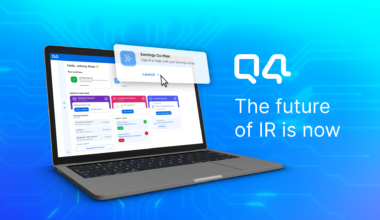Welcome back to our first trending earnings recap, January 2022 on trending topics, macro trends and key management commentary highlighted from earnings call transcripts of S&P 500 companies for the Q4’21 earnings season. As earnings kicked off last week with three of the “Big Four” banks in the U.S., here are four trending topics that emerged during earnings updates from the week of January 10th, 2022:
- Inflation, labor shortages and supply chain issues: Alongside inflationary pressures, the looming labor shortages and supply chain issues tied to COVID-19 will continue to incur transitory costs as companies are focused on meeting the demand of consumers, creating a challenge for capital expenditures and investment planning in 2022.
This earnings season, a key topic of consideration will be the interest rate hikes that are being considered for 2022 by the U.S. Federal Reserve, and how the news of a possible rate hike in March could impact the economy, and specifically the stock market.
The second big issue on the agenda right now is the Federal Reserve. We have a meeting, the December FOMC meeting coming up next week, and I expect the Fed to double the pace of its tapering program, its tapering of asset purchases at that meeting…I think given the strength in inflation, they would like to have the option to hike interest rates a little bit sooner, and so, I think they will double the pace. That would mean that after $30 billion per month tapers implemented in January, February and March, the asset purchase program, or sometimes called the QE program, would come to an end. Now, rate hikes would then be on the table on subsequent meetings. I think the March meeting is a little bit too quick of a turnaround time, but I suspect that they will deliver the first rate hike at either the May or the June meeting, and then they’ll basically go every other meeting for the duration of 2022
- David Mericle – Goldman Sachs & Co. LLC, Chief US Economist
So let us try to give you more detail around forward-looking drivers that could be headwinds or tailwinds. So first, the rate curve. Our central case does not require a return to a 2.5% Fed funds target rate, as the current forward curve only prices in 625 basis point hikes over the next three years…In this illustration, the downside assumes that rates stay relatively constant to current spot rates, whereas upside would be driven by a combination of a steeper yield curve and more hikes, together with a more favorable deposit reprice experience. And of course, what we are evaluating here is the impact of rates in isolation on NII. But for the performance of the company as a whole, credit matters a lot, and the reason why rates are higher will have an impact on that.
- Jeremy Barnum – JPMorgan Chase & Co., Chief Financial Officer
The second thing I’d point out is the assumptions around interest rate hikes in 2022. As many as three or four, depending on the economist view that you listen to, and that obviously is going to play to our favor as well when you think about the number of accrual businesses that we have whether it’s our TTS franchise or our Private Bank, et cetera, et cetera. So those are important factors that impact the top line and that we expect to help contribute to some growth coming out of 2022.
- Mark A. L. Mason – Citigroup, Inc., Chief Financial Officer
So inflation in general is a net positive. Hard to say it that way. But what it does is because of the segment of the market that we’re in, we have relatively more pricing power than if you were in the enterprise space, although I suspect they’ll have more pricing power. So it gives us in terms of our model a measure of ability to price that may be a little bit higher than we have experienced in previous years to the extent that inflation also drives interest rates higher, that also has a benefit to the business. So obviously, there’s a balance there in terms of if interest rates and inflation surge too high, could have a dampening effect on economic growth. But assuming it’s under some reasonable level, it’s going to be a net positive for the business.
- Efrain Rivera – Paychex, Inc., Chief Financial Officer, Treasurer & Senior Vice President
Alongside inflationary pressures, the looming labor shortages and supply chain issues tied to COVID-19 will continue to incur transitory costs as companies are focused on meeting the demand of consumers, creating a challenge for capital expenditures and investment planning in 2022.
Input cost inflation came in higher than expected in the quarter. In addition, we made some strategic decisions to service the heightened consumer demand we continued to experience as the entire industry incurred transitory costs associated with labor shortages, supply issues on
materials and transportation cost and congestion challenges…we currently expect gross inflation to be approximately 14% for fiscal 2022 compared to the approximately 11% we anticipated at the time of our first quarter call. This is a large increase, and we’re taking actions to offset the increase while still investing in the long-term health of our business
- Sean M. Connolly – Conagra Brands, Inc., President, Chief Executive Officer & Director
I mean, look, I mean, just like pretty much every other company and management team in the US, we’re dealing with supply chain issues, upward pressure on labor costs. But I don’t think that we have seen it to such an extent that we’re going to say that we can’t meet the capital plan. We have every intention and we have every confidence we’re going to meet the capital plan. We tried to give a little color to it with respect to that on the call today. We have moved aggressively to tie up more construction crews. We have expanded our vendor base in and around that area. One of the tools that we got in the new legislative process is the ability to put long lead time items into inventory and into rate base. So we’re looking at all of those.
- David J. Lesar – CenterPoint Energy, Inc., President, Chief Executive Officer & Director
We estimate the effect of labor shortages on our Q2 results was approximately $470 million, in line with our original expectations, and consistent with the first quarter, Ground once again bore the majority of these costs to the tune of $285 million.
While Ground’s results were negatively affected by labor challenges in the first half of the year, we are encouraged by hiring momentum as we look to the second half and are focused on retaining recently hired team members after the peak season concludes.
- Mickey Foster – FedEx Corp., Vice President-Investor Relations
We have other businesses like our interest rate futures and, to a certain degree, inflation-oriented products like commodities that tend to do better in high interest rate environments. And so, from a transaction standpoint, we wanted to be durable. We want to grow on top of growth and not be a name where people pile in when interest rates are going up and pile out when interest rates are going down.
And so, the more that we feel like we can lock into growing and recurring revenue, it gives investors a basis to know that we’re going to continue to pay a dividend, that we’re going to have capital to reinvest in the business. And then, if we can have transaction businesses that, regardless of macro environment, can do well.
- Jeffrey Craig Sprecher – Intercontinental Exchange, Inc., Chairman & Chief Executive Officer
Earnings Q&A Analysis
The data referenced below is based on a proprietary Q4 analysis performed on the Earnings Call Q&A sessions of S&P 500 organizations within the “Asset Managers & Diversified Banks” industry (BLK, JPM, WFC, C) that reported earnings last week. The chart below highlights the key topics that analyst queries focused on, displayed as a % of all questions asked.
As per the chart, Net Interest Income Outlook and Buyback were two of the key trending topics, covering 13% and 6% of the questions asked respectively. Asset Cap, Investment Allocation and Loan Growth were tied for the 3rd place with about 12% (cumulative) of questions mentioning these topics.
About 48% of all questions focused on topics related to Business Drivers, while 22% focused on Guidance, as companies report on their 2022 outlook/guidance during this earnings season.


